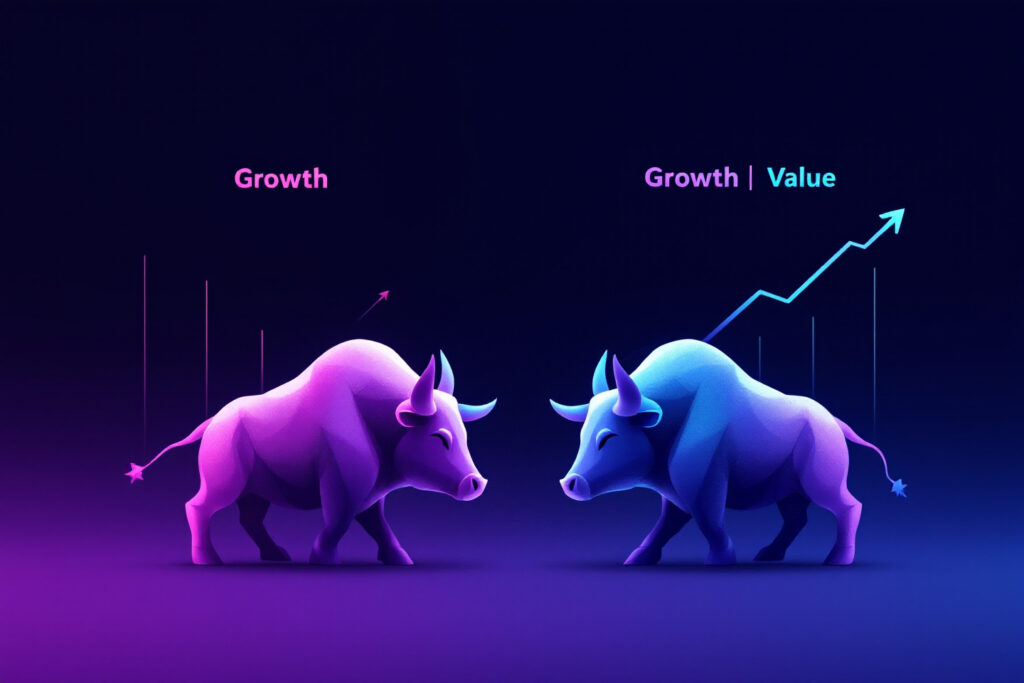If you’re serious about investing in high-quality stocks, understanding and analyzing PER (Price-to-Earnings Ratio), PBR (Price-to-Book Ratio), and ROE (Return on Equity) is essential. These three core financial metrics are powerful tools that help investors assess a company’s valuation, financial health, and profitability.
In this guide, you’ll learn what each metric means, how to interpret them in real-world scenarios, and how to use them together to make smart investment decisions.
What is PER (Price-to-Earnings Ratio)?
✅ Definition:
PER = Current Stock Price / Earnings Per Share (EPS)
It tells you how much investors are willing to pay today for $1 of the company’s earnings. In short, it’s a valuation metric.
✅ How to Interpret:
- High PER: Investors expect strong future growth (can mean overvaluation or high confidence).
- Low PER: May indicate undervaluation, or low growth expectations (or a troubled business).
📌 Example:
- Company A has a stock price of $100 and EPS of $5 → PER = 20
- This means investors are paying $20 for every $1 of current earnings.
⚠️ Caution:
- PER is most useful when compared with industry peers or a company’s historical average.
- High-growth tech companies often have higher PERs than mature industries like utilities.

What is PBR (Price-to-Book Ratio)?
✅ Definition:
PBR = Current Stock Price / Book Value Per Share
Book Value = Total Assets – Total Liabilities
It shows how the market values the company relative to its net assets.
✅ How to Interpret:
- PBR = 1: The stock is trading at its book value.
- PBR < 1: Possibly undervalued (investors paying less than the company’s net worth).
- PBR > 1: Market values the company above its book value (often due to expected growth or strong brand).
📌 Example:
- If a stock trades at $50 and its book value per share is $25 → PBR = 2.0
⚠️ Caution:
- A low PBR could signal value—or reflect real problems (e.g., declining profitability).
- A high PBR is justified only if the company can generate returns above its cost of equity.
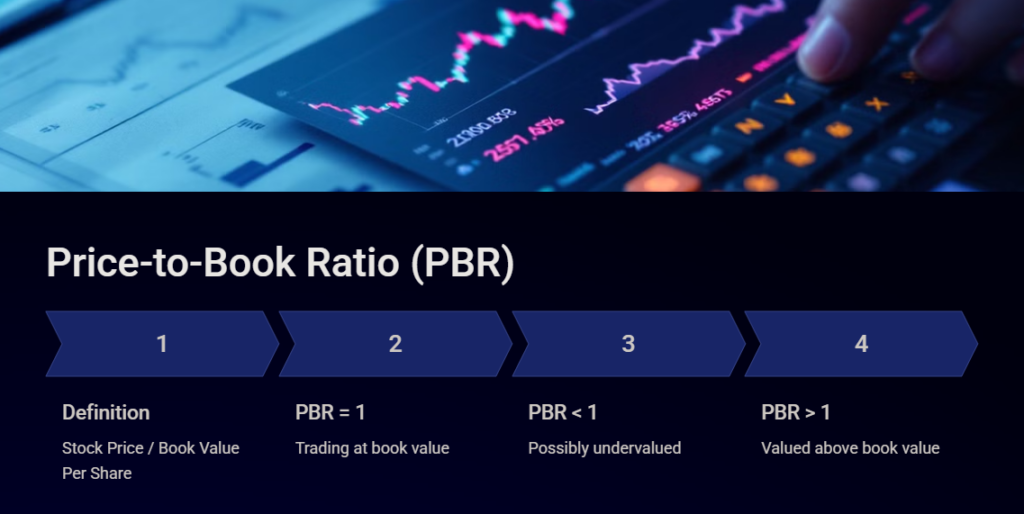
What is ROE (Return on Equity)?
✅ Definition:
ROE = Net Income / Shareholder’s Equity
It measures how effectively a company is using shareholders’ money to generate profits.
✅ How to Interpret:
- Higher ROE = More efficient at generating profits from equity
- Often used to evaluate management performance
📌 Example:
- A company with net income of $2 million and equity of $10 million → ROE = 20%
📊 General Benchmarks:
- ROE < 10%: Below average
- ROE 10–15%: Healthy
- ROE > 15%: Strong profitability
⚠️ Caution:
- A very high ROE could be a result of high debt rather than strong operations.
- Look at the company’s debt-to-equity ratio in tandem with ROE.
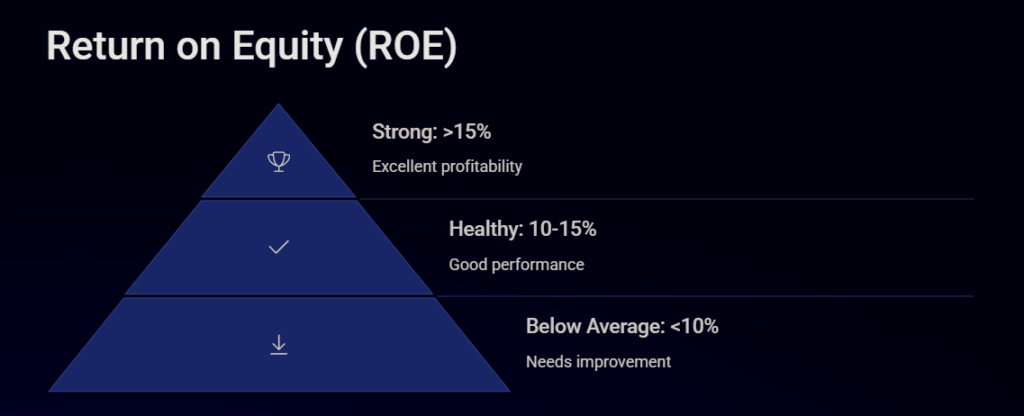
How to Use PER, PBR, and ROE Together
Using these three metrics in combination gives you a fuller picture:
| Metric | What It Tells You |
|---|---|
| PER | Valuation vs. Earnings |
| PBR | Valuation vs. Assets |
| ROE | Profitability vs. Shareholder Equity |
✅ Ideal Combination for a Strong Investment:
- Moderate PER (not overvalued)
- Low-to-moderate PBR (value opportunity)
- High ROE (strong, efficient company)
📌 Tip: Look for companies with low PER and PBR but high ROE—these are often undervalued gems with strong fundamentals.
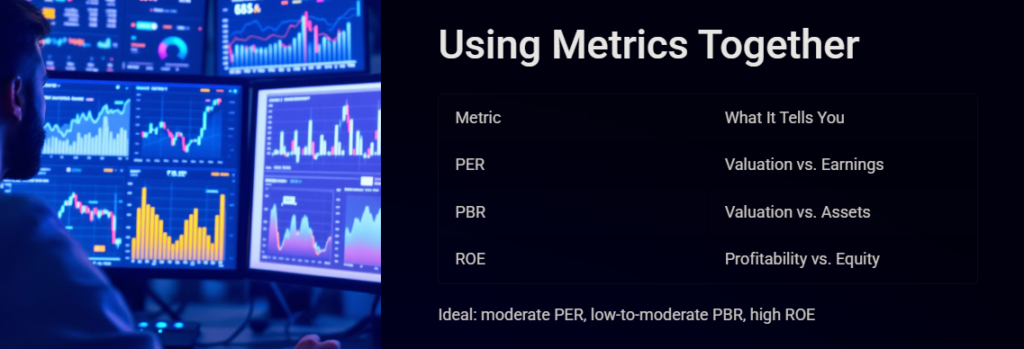
Case Study: Applying the Metrics to Real Stocks – NVIDIA vs. Apple
Analyzing real-world companies using PER, PBR, and ROE can give us deeper insight into how the market values these businesses and how efficiently they generate profit.
Here’s a comparison based on the most recent data:
| Metric | NVIDIA(NVDA) | APPLE(AAPL) |
|---|---|---|
| PER | 39.98 | 30.91 |
| PBR | 36.54 | 56.72 |
| ROE | 119.18 | 151.07 |
🔍 1. PER (Price-to-Earnings Ratio)
- NVIDIA: 39.98
- Apple: 30.91
📌 Interpretation:
Both companies are trading at relatively high PERs, indicating that investors are willing to pay a premium for their earnings—this reflects strong growth expectations.
- NVIDIA’s PER of ~40 means the market is paying $40 for every $1 of its earnings.
- Apple’s PER of ~31 is slightly lower, suggesting it’s less aggressively priced relative to its earnings.
➡️ Verdict:
Both are growth stocks, but Apple may offer a better valuation relative to its earnings.
🔍 2. PBR (Price-to-Book Ratio)
- NVIDIA: 36.54
- Apple: 56.72
📌 Interpretation:
These are very high PBR values, especially compared to traditional value investing benchmarks where PBR below 3 is considered reasonable.
- NVIDIA’s market cap is 36 times higher than its book value.
- Apple’s market cap is even 57 times higher than its book value.
This suggests both companies have intangible assets (like brand power, ecosystem value, R&D strength) that the market is heavily pricing in.
➡️ Verdict:
Such high PBRs are common in tech giants, where the book value underrepresents the company’s true market potential. These aren’t value stocks—they’re premium growth stocks.
🔍 3. ROE (Return on Equity)
- NVIDIA: 119.18%
- Apple: 151.07%
📌 Interpretation:
These ROE values are exceptionally high, meaning both companies generate massive returns on shareholders’ equity.
- Apple earns $1.51 for every $1 of equity invested by shareholders.
- NVIDIA earns $1.19 per $1 of equity.
Such high ROEs often indicate:
- Strong profitability
- Efficient use of capital
- Possibly high financial leverage (important to check the company’s debt levels too)
➡️ Verdict:
Both companies are extremely efficient at generating profits. Apple, in particular, has one of the highest ROEs among publicly traded companies.
Think Like a Pro
Understanding PER, PBR, and ROE allows you to move beyond hype and headlines. Instead of chasing hot trends, you can evaluate real business fundamentals.
📌 These metrics are not perfect in isolation, but when used together, they form a solid foundation for long-term investing success.
“Price is What you Pay, Value is What You Get.” – Warren Buffett
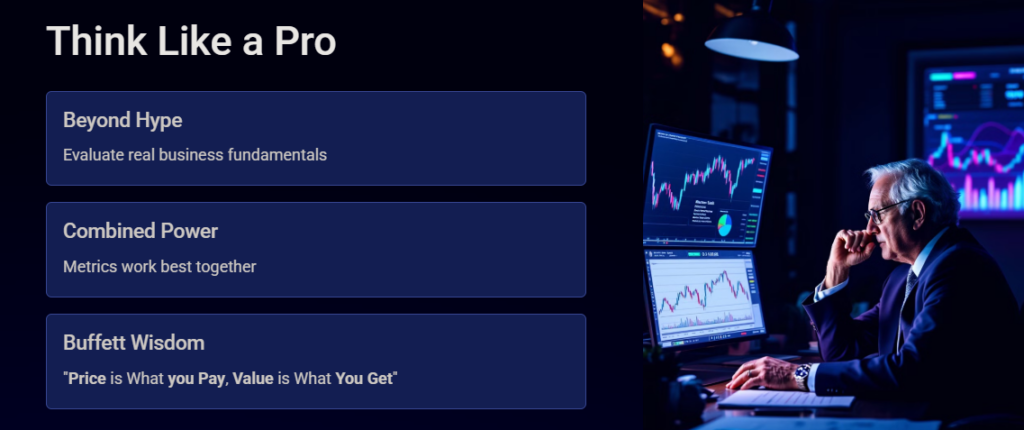
🔜 Coming Soon on the Blog
- “5 Expert Tips to Achieve Financial Freedom“
- “How to Discover High-Quality U.S. Stocks Using Yahoo Finance”
- “Growth vs. Value Stocks: Which Strategy Wins Long-Term?”
